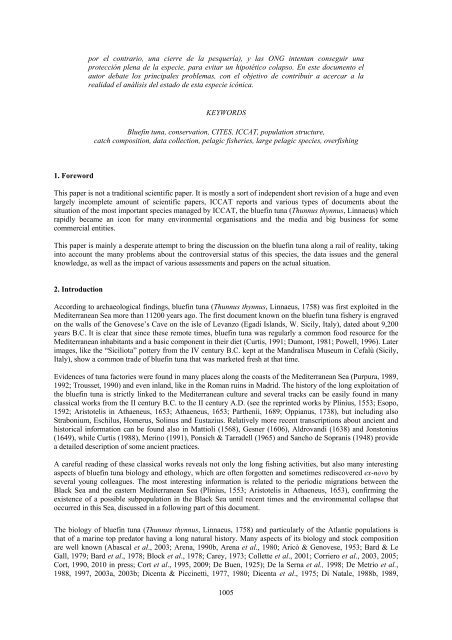1. Foreword por el contrario, una cierre de la pesquería), y las ONG intentan conseguir una protección plena de la especie, para evitar un hipotético colapso. En este documento el autor debate los principales problemas, con el objetivo de contribuir a acercar a la realidad el análisis del estado de esta especie icónica. KEYWORDS Bluefin tuna, conservation, CITES, ICCAT, population structure, catch composition, data collection, pelagic fisheries, large pelagic species, overfishing This paper is not a traditional scientific paper. It is mostly a sort of independent short revision of a huge and even largely incomplete amount of scientific papers, ICCAT reports and various types of documents about the situation of the most important species managed by ICCAT, the bluefin tuna (Thunnus thynnus, Linnaeus) which rapidly became an icon for many environmental organisations and the media and big business for some commercial entities. This paper is mainly a desperate attempt to bring the discussion on the bluefin tuna along a rail of reality, taking into account the many problems about the controversial status of this species, the data issues and the general knowledge, as well as the impact of various assessments and papers on the actual situation. 2. Introduction According to archaeological findings, bluefin tuna (Thunnus thynnus, Linnaeus, 1758) was first exploited in the Mediterranean Sea more than 11200 years ago. The first document known on the bluefin tuna fishery is engraved on the walls of the Genovese’s Cave on the isle of Levanzo (Egadi Islands, W. Sicily, Italy), dated about 9,200 years B.C. It is clear that since these remote times, bluefin tuna was regularly a common food resource for the Mediterranean inhabitants and a basic component in their diet (Curtis, 1991; Dumont, 1981; Powell, 1996). Later images, like the “Siciliota” pottery from the IV century B.C. kept at the Mandralisca Museum in Cefalù (Sicily, Italy), show a common trade of bluefin tuna that was marketed fresh at that time. Evidences of tuna factories were found in many places along the coasts of the Mediterranean Sea (Purpura, 1989, 1992; Trousset, 1990) and even inland, like in the Roman ruins in Madrid. The history of the long exploitation of the bluefin tuna is strictly linked to the Mediterranean culture and several tracks can be easily found in many classical works from the II century B.C. to the II century A.D. (see the reprinted works by Plinius, 1553; Esopo, 1592; Aristotelis in Athaeneus, 1653; Athaeneus, 1653; Parthenii, 1689; Oppianus, 1738), but including also Strabonium, Eschilus, Homerus, Solinus and Eustazius. Relatively more recent transcriptions about ancient and historical information can be found also in Mattioli (1568), Gesner (1606), Aldrovandi (1638) and Jonstonius (1649), while Curtis (1988), Merino (1991), Ponsich & Tarradell (1965) and Sancho de Sopranis (1948) provide a detailed description of some ancient practices. A careful reading of these classical works reveals not only the long fishing activities, but also many interesting aspects of bluefin tuna biology and ethology, which are often forgotten and sometimes rediscovered ex-novo by several young colleagues. The most interesting information is related to the periodic migrations between the Black Sea and the eastern Mediterranean Sea (Plinius, 1553; Aristotelis in Athaeneus, 1653), confirming the existence of a possible subpopulation in the Black Sea until recent times and the environmental collapse that occurred in this Sea, discussed in a following part of this document. The biology of bluefin tuna (Thunnus thynnus, Linnaeus, 1758) and particularly of the Atlantic populations is that of a marine top predator having a long natural history. Many aspects of its biology and stock composition are well known (Abascal et al., 2003; Arena, 1990b, Arena et al., 1980; Aricò & Genovese, 1953; Bard & Le Gall, 1979; Bard et al., 1978; Block et al., 1978; Carey, 1973; Collette et al., 2001; Corriero et al., 2003, 2005; Cort, 1990, 2010 in press; Cort et al., 1995, <strong>2009</strong>; De Buen, 1925); De la Serna et al., 1998; De Metrio et al., 1988, 1997, 2003a, 2003b; Dicenta & Piccinetti, 1977, 1980; Dicenta et al., 1975; Di Natale, 1988b, 1989, 1005
2004b, 2007; Di Natale et al., 2003, 2005b, 2006b, 2006c; Duclerc et al., 1973, 1974; Farrugio, 1980, 1981; Frade, 1925; Ely et al., 2002; Fournestin & Dardignac, 1962; Fromentin, 2002a; Fromentin et al., 2000; Garcia et al., 2003a, 2003b, 2005; Garibaldi F., 2004; Genovese, 1953a, 1956a, 1956b, 1958, 1960; Gordoa et al., <strong>2009</strong>; Heldt, 1927, 1932; Karakulak et al., 2004a, 2004b; Lalami et al., 1973; Lanteri, 2007; Liorzou & Bigot, 1995; Liorzou et al., 2001; Mather et al., 1974, 1995; Morovic, 1961; Oray et al., 2005; Oray & Karakulak, 2005; Orsi Relini, in press; Orsi Relini et al., 1994, 1995°, 1995b, 1997, 1998, 1999a, 1999b, 2007; Ottolenghi & Cerasi, 2008; Piccinetti, 1973, 1995; Piccinetti et al., 1977, 1981, 1995, 1999; Piccinetti & Piccinetti Manfrin, 1979, 1980; Piccinetti-Manfrin, 1970, 1994; Relini et al., 1995; Richards, 1976; Rivas, 1978; Rodriguez-Roda, 1964; 1967, 1969c, 1975; Roule, 1913, 1914a, 1914b, 1916a, 1916b, 1917a, 1917b, 1917c, 1918, 1919, 1921, 1923, 1925; Safina, 2001; Sanz Brau, 1990; Sanzo, 1909, 1910, 1932; Sarà, 1973; Scaccini, 1953, 1963, 1966, 1968; Scaccini et al., 1975; Scordia, 1930, 1931, 1933, 1934a, 1934c, 1935b, 1936a, 1937a, 1937b, 1938b, 1939a; Sella, 1924, 1929b, 1932; Spagnolio, 1938), while many others are still unknown. The recent genetic studies sometimes provides useful pieces of the biological puzzle of this species, while some others are putting new questions (Alvarado Bremer et al., 2005; Broughton & Gold, 1997; Cimmaruta et al., 1999; Carlsson et al., 2004; Clark et al., 2004; Ely et al., 2002; Ferrara et al., in press; Landi et al., 2007; McDowell et al., 2002; Riccioni et al., in press; Tagaki et al., 1999; Vella, <strong>2009</strong>). At the same time, this species is considered a good ecological indicator, a mirror of the different concentrations of pollutants (Corsolini et al., 1999; Licata et al., 2005; Orsi Relini et al., 2007) The fishery of the bluefin tuna is also a part of the story of the human bean: besides the tuna traps, that are discussed later in detail, the fishery was always a mirror of the advanced technologies, starting from simple hand lines to the modern and sophisticated tuna purse seiners (Arena, 1982d, 1986b, 1990a, 1990c; Arena et al., 1980; Arena & Di Natale, 1987; Bard & Le Gall, 1979; Bellón Uriarte, 1926; Berthelot, 1868; Cau, 1991, 1996; Cau et al., 1999; Cavallaro et al., 1996; D’Amanich, 1954; De La Blanchère, 1868; De la Serna et al., 1998; Desse & Desse-Berset, 1994; De Stefano, 2006; Dieuzeide, 1931; De Metrio et al., 1999; Di Natale, 1988a, 1988c, 1990, 1991, 1996, 1999; Di Natale et al., 1987, 1988a, 1988b, 1989, 1993, 1996, 2003, 2004; 2005a, 2005b, 2006a; Di Natale & Mangano, 2008; Doumenge, 1953, 1955, 1956, 1998; Duhamel de Monceaus, 1769-1782; Duviard, 1992; Farrugio, 1978, 1980, 1981; Ferrandis Ballester et al., 1997; Ferraro, 1986; Fromentin, 2002, 2003; Gordoa et al., 2004; Heldt, 1932; La Marhadour, 1914; Liorzou & Bigot, 1991; Liorzou et al., 2001; Mackenzie & Mayers, 2007; Mackenzie et al., <strong>2009</strong>; Mielgo Bregazzi, 2006, 2008, <strong>2009</strong>; Ninni, 1917, 1921a; Northridge et al., 1991; Oren & Ben Tuvia, 1954, 1959; Orsi Relini et al., 1993, 1996; Ottolenghi & Cerasi, 2008; Parona, 1919; Pommereau, 1955; Pavesi, 1889; Piccinetti, 1980; Piccinetti & Farrugio, 1980; Piccinetti & Piccinetti Manfrin, 1999; Potoschi & Sturiale, 1999; Rodriguez Santamaria, 1923; Roule, 1914a, 1914b, 1916a, 1921; 1924; 1925; Sañez Reguart, 1781; Sarà, 1963; Scaccini, 1951, 1953, 1965, 1973; Scaccini & Biancalana, 1959; Scordia, 1934b, 1936b, 1940a; Sella, 1929b; Sion et al., 1999; Susca et al., 2001). The recent adoption of the caging system in the Mediterranean to increase the added value of the fattened tuna on the market can be tracked in the papers by De Stefano & Van Der Heijden (2007), D’Amico & La Via (2007); Di Trapani (2008); Doumenge (1999), Katavic et al. (2003), Lioka et al., 2000, Mielgo Bregazzi (2006, 2008, <strong>2009</strong>), Miyake et al. (2003), Ottolenghi & Cerasi (2008) Piccinetti (1980) and Repetto et al. (2001). The story of the bluefin tuna fishery also shows large temporal holes over the centuries, maybe because it was a common activity and possibly the literature was mostly dealing with more elegant issues. It is also true that the same holes exist in several natural history areas. According to what Aristotelis (in Athaeneus, 1653) said, “thynnum esse tradit gregalem ac locum mutare”, this species is a very migrant one, able to cross the ocean in a short time, and to carefully read the chemical and physical messages from the sea waters. The bluefin tuna migrations are huge and only partly known even today. Big changes in the distribution pattern have been reported so far, but most of them are known in the last century (Aloncle, 1964; Arena, 1971; Brill, 1994; Brill & Lutcavage, 2001; Cort & Liorzou, 1991, 1995; Cort & De la Serna, 1994; Cort & Rey, 1983; De Metrio, 2005; De Metrio et al., 2001; Fromentin, 2002b; Genovese, 1959; ICCAT, <strong>2009</strong>; Lozano Cabo, 1959a, 1959b; Mather 1962a, 1962b; Mather et al., 1967, 1974, 1995; Naccari, 1872; Ninni, 1922; Pavesi, 1887; Rey, 1979, 1992, 1999; Rivas, 1976; Rodríguez-Marín et al., <strong>2009</strong>; Rodriguez- Roda, 1959, 1969b, 1980a, 1983; Rooker et al., 2007; Roule, 1924b; Sarà, 1963, 1964; Scordia, 1938, 1939a, 1940b; Sella, 1926a, 1926b, 1927, 1929, 1930,1931, 1932). It is very difficult to track the story of this fishery through the centuries until the 16 th century, because the information is scattered in poems, literature, romances and commercial notes. Only from 1500 onwards is it possible to find some good reports and even figures and engravings, beginning from Braun & Ogenberg (1572- 1617), which help us to better understand how the exploitation was developed in the last 500 years. 1006
- Page 1: SCRS/2009/189 Collect. Vol. Sci. Pa
- Page 5 and 6: How these variations can be interpr
- Page 7 and 8: al. (2003). It was clear that the c
- Page 9 and 10: Contracting Party or fishing entity
- Page 11 and 12: data substitution on the assessment
- Page 13 and 14: shortening the spawning seasons (as
- Page 15 and 16: properly analyse if the current sit
- Page 17 and 18: Arena P., 1988b, Rilevazioni e stud
- Page 19 and 20: Corriero A., Desantis S., Deflorio
- Page 21 and 22: Di Natale A, 1988b, I Pesci tipici
- Page 23 and 24: Farrugio H., 1979 - La peche du Tho
- Page 25 and 26: Karakulak S.F., Oray I., 2009, Rema
- Page 27 and 28: Oren O.H., Ben Tuvia A., 1959, Expe
- Page 29 and 30: Rodriguez-Roda J., 1959, Aparicíon
- Page 31 and 32: Scaccini A., 1953, La campagna di s
- Page 33 and 34: Trousset P., 1990, La vie littorale
- Page 35 and 36: Figures 2 and 3. Tuna market depict
- Page 37 and 38: Figure 7. The most typical composit
- Page 39 and 40: Figure 10. Descriptive figure of a

















